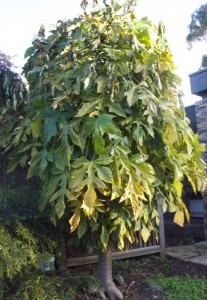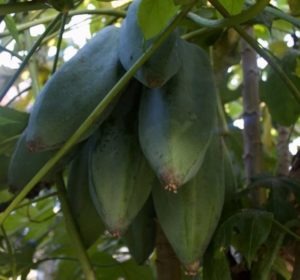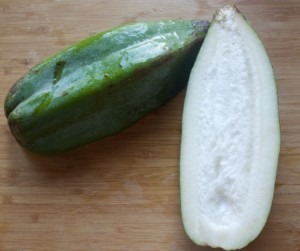Babaco Carica pentagona is compact, high yielding and more frost tolerant than its close relative papaya (or paw paw) – an excellent candidate for sustainable gardens around the country.
A native of Ecuador, the herbaceous shrub is grown commercially in New Zealand, Israel and southern California. Its fruit, which is yellow when ripe and shaped like a torpedo, is sometimes called Champagne Fruit for its refreshing, effervescent flesh. Some say it tastes like a cross between strawberry, papaya and pineapple.
Position
The babaco grows to about 2.5 metres and does best in a mild, fairly humid climate. It must get enough sun or it will not set fruit. It only tolerates light frosts, though if it loses leaves in heavier frosts, it may recover. Plant in a position protected from wind and preferably shaded from hot afternoon sun.
 Soil
Soil
It needs a well-drained soil enriched with organic matter. It is fast growing and should be fertilised often especially during the fruiting season. Use a good quality fertiliser and mulch (composted chicken manure is recommended) and water well. Keep mulch and fertiliser away from the stem. Babaco will grow well in a large container as long as a good, free draining potting mix is used. Babaco does not tolerate salty soil and it is best to avoid watering with grey water.
Flowering and fruiting
 The large, palmate leaves are on long leaf stalks that radiate from the trunk. The flowers, which are all female, form on the developing trunk. The fruits set straight after flowering and start to expand quickly. They are pentagonal in shape, pointed at the apex and rounded where they attach to the stem. As they ripen yellow patches appear on the green skin and these spread until the whole fruit is yellow and ripe. The fruit can be picked when patchy and will ripen off the plant. The fruits lowest on the stem ripen first. The average lifespan of a babaco plant is eight years and it may produce between 30 and 60 fruit a year.
The large, palmate leaves are on long leaf stalks that radiate from the trunk. The flowers, which are all female, form on the developing trunk. The fruits set straight after flowering and start to expand quickly. They are pentagonal in shape, pointed at the apex and rounded where they attach to the stem. As they ripen yellow patches appear on the green skin and these spread until the whole fruit is yellow and ripe. The fruit can be picked when patchy and will ripen off the plant. The fruits lowest on the stem ripen first. The average lifespan of a babaco plant is eight years and it may produce between 30 and 60 fruit a year.
Propagation
Babaco fruits are seedless and can therefore only be propagated by cuttings. Cut up either the old trunk or small branches and leave them to dry out for a few days. Then plant out in potting mix or compost. The plant does not need to be pollinated.
Pests and diseases
It is important that the babaco plant is in well-drained soil as it succumbs easily to root rot – too much water means it is difficult for the roots to get air, causing them to decay. There is not much one can do once the plant has root rot. One option, though, is to cut off and propagate the stem. Very humid conditions can trigger powdery mildew so allow plenty of air circulation. Apart from a susceptibility to some mites, babaco is relatively pest and disease free.
Pruning
For the best results, only one trunk should be allowed to grow. Remove shoots that form around the base of the plant. In early spring, allow one of these shoots to develop. This shoot will grow rapidly but will not flower and interfere with the current season’s fruit. After harvest, prune the main stem back to 20cm and the remaining shoot will now develop and become the next main trunk.
Uses
 The fruit has thin edible skin and no seeds. It is not very sweet, but can be used in a tropical fruit smoothie, a chilled fruit cocktail or a fruit salad. Another option is to slice them, sprinkle with sugar and leave in the fridge for a few hours before serving. Unripe green fruit can be used as a vegetable in curries and chutney. The whole fruit can be used in jam or added to fruit pies. Babaco will keep on the shelf for up to four weeks. The ripe fruit is rich in Vitamin C. Babaco also contains the meat tenderiser papain, another good reason to use them in curries and stews with meat.
The fruit has thin edible skin and no seeds. It is not very sweet, but can be used in a tropical fruit smoothie, a chilled fruit cocktail or a fruit salad. Another option is to slice them, sprinkle with sugar and leave in the fridge for a few hours before serving. Unripe green fruit can be used as a vegetable in curries and chutney. The whole fruit can be used in jam or added to fruit pies. Babaco will keep on the shelf for up to four weeks. The ripe fruit is rich in Vitamin C. Babaco also contains the meat tenderiser papain, another good reason to use them in curries and stews with meat.
Planting
In cold parts of Australia, babaco from the nursery are at their best in spring and summer and it is wise to get them established in these warmer months. In frost free climates, plant all year round.
Recipes
Babacos mix well with other fruits, taking on their flavour and adding just that little special extra of their own. They are also a good base for chutneys and jams.
Green babaco chutney
This chutney complements Indian-style dishes. You need a mature babaco which is approaching ripening – the fruit should be green with a slight hint of yellow.
1 ½ kg green babaco, peeled and cut into cubes
60g fresh ginger, peeled and grated
6 garlic cloves, chopped
1 large onion, chopped
1 teaspoon salt
½ teaspoon chilli flakes
2 cups castor sugar
1 cup cider vinegar
5 black peppercorns
10 cardamom pods
1 bay leaf
Place babaco, ginger, onion, salt, chilli and sugar in a pot. Cover and stand overnight in the fridge. The next day, cook over a medium heat until thickened, about one hour.
Stir through vinegar, peppercorns, cardamom pods and bay leaf. Bring back to the boil, allow to cool slightly then pour into sterilised jars. Keep for one month before eating.
From: www.localfoodconnect.org.au/green-babaco-chutney/ Author: Stephen Onians
Babaco and Ginger Jam
1 ½ kg babaco pieces (green babaco can be used)
200g preserved ginger
1 ½ cups water
Juice 1 lemon
½ cup of ginger syrup
1kg sugar
Boil all except sugar for 15 minutes. Add sugar and boil hard until set.
Pour into sterilised jam jars and seal.
From: The Archives of the Rare Fruit Council of Australia
Megan Hallowes started her career as a journalist in South Africa, then worked as an editor and writer in Australia. She lives in Melbourne with her husband and two children and is working towards a bountiful garden of veggies, herbs and fruit trees.
Further Reading
http://www.fruitsinfo.com/babaco-tropical-fruits.php#Babaco Facts
http://www.crfg.org/pubs/ff/babaco.html
Related Articles:
Companion Planting
Heard about companion planting but don’t know what it is or where to start? This video explores how to use companion plants to improve the health…
Garden Journaling – Slow down to tune in.
As we move through the year and our gardens evolve, there's something magical about documenting the journey. Garden journaling is an art that enables…
Strawberries
I adore strawberries (Fragaria sp.), and one of my earliest memories is a birthday cake absolutely heaving under the weight of a sack full of home…
Climate Resilient Gardening
Introduction Gardeners in Australia are facing a race against time as they experience the growing impact of climate change in their own gardens. The…




